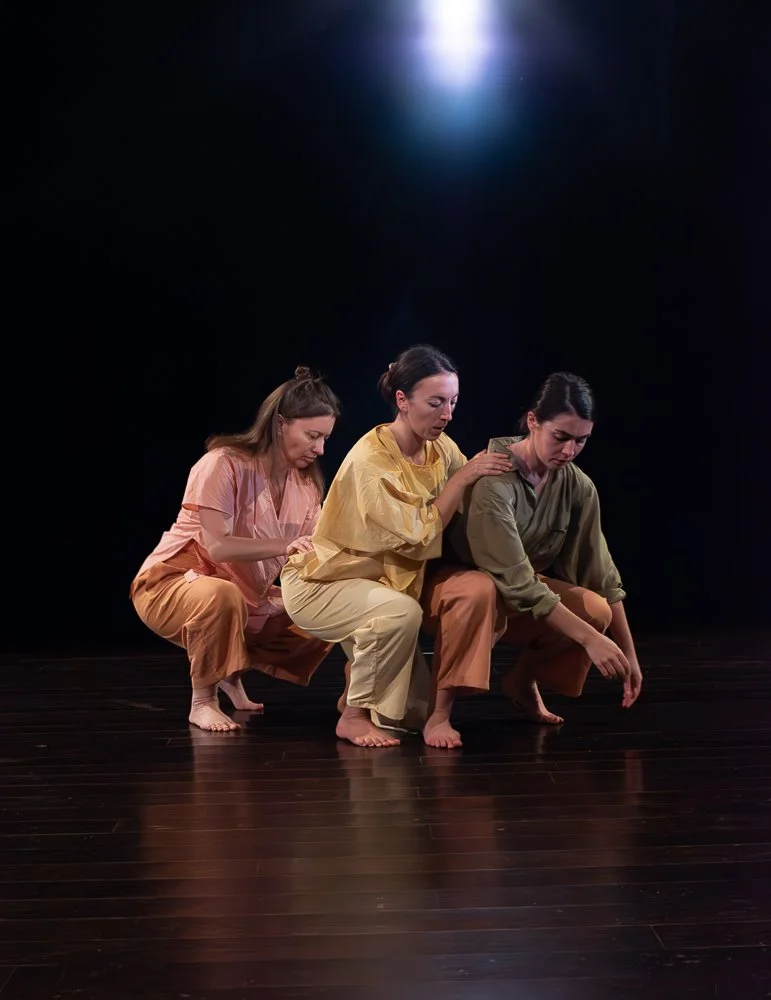Half Light, Holly Thomas
Half Light, Holly Thomas © Vonalina Cake
“Two dancer’s bodies become root, boulder, branch, tree.”
Not my description of Holly Thomas’ Half Light but the work’s narrator’s. As Holly (in the role of Twilight) rolled across and tapped her feet tentatively along two hunched over dancers, a fourth performer gave context to the movement, transporting us from our 360 seating on The Place’s stage to a mossy woodland, which Twilight was navigating to get home to her child.
Half Light, Holly Thomas © Vonalina Cake
Half Light is a dance work created first and foremost for visually impaired audiences. The narration was in effect poetic audio description, which conjured images of semi-mystical landscapes while describing dancers’ movement and placement. Sound was at the heart of this work and its greatest success. At moments we were instructed to close our eyes and listen as two dancers ran, collided and skidded around the stage and behind us. Dancers are normally required to be soft of foot, so early on in the process they unlearnt this basic training in order for their movement to be heard. Who would have thought there were so many tonal variations in a footstep? Squeaks from the friction of skin on rubbery floor started low and long with a high final squeal. Harsher slaps of more immediate impact were low and vibrating, enhanced by the soundtrack’s bassey drones. At times, the score was also woven into the choreography. Speakers were placed around the stage as pre-recorded voices of the characters, or circulated around us by the dancers so different instruments became what we heard most. The innovation was brilliant.
Half Light, Holly Thomas © Vonalina Cake
However, the audio was also its downfall. The script took us from the realism of Twilight’s birth and early diagnosis of visual impairment to the surrealism of her child becoming a magpie, via scientific descriptors of the phases of the night. It was unfortunately a case of too many ideas – even with a narrator I was confused as to what was going on. A focus on audio as the driving force also took away from the visual experience. There was minimal dance accompanying the work, making it more of a play than advertised, meaning that those with auditory impairments were left with a patchy experience (I type this with full understanding that the intended audience was those with sight loss and that you can’t necessarily cater for everyone, but having interacted with audiences members at the performance with hearing loss, feel compelled to note this).
This lack of dance was a lost opportunity. Not just because it limited the experience for those with certain disabilities, but because the dance content that was included had such promise. Near the end, Twilight jumped into a cave pool. She was lifted and spun in a freeing moment of beauty, before encountering a Salamander, the dancer for whom crawled tentatively across the floor on her knees, toes flexing, neck circling. It captured the folkish whimsy at the centre of the work – more of this please!
Find your next dance show
All dance shows happening across the UK, all in one place. Only on Like Nobody’s Watching.
Check out these related reviews
🪩 Brought to you by Like Nobody’s Watching. Read about our mission →





